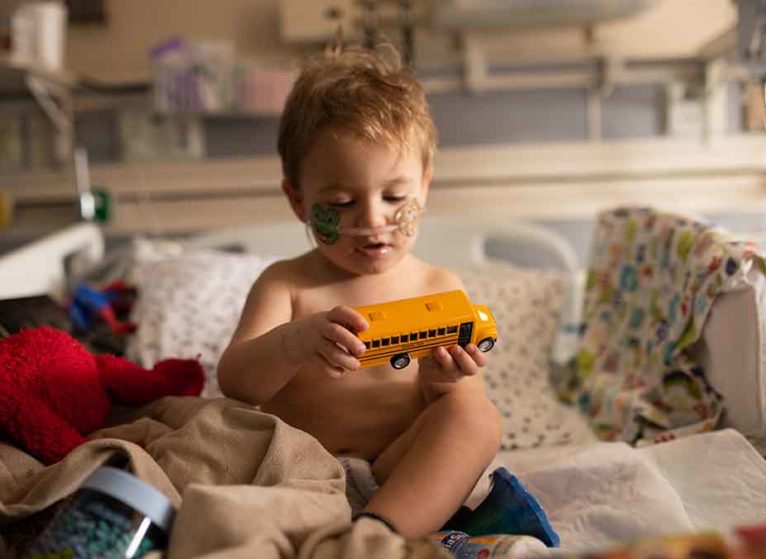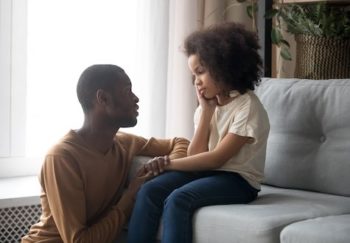Facemasks. Good hand hygiene. Social distancing. Over the past year, they were of course meant to slow the spread of COVID-19. But another effect we’ve seen? Record low levels of other seasonal viruses like flu and RSV.
But now that things are opening back up, pediatricians are seeing an unseasonal rise in RSV. Debbie-Ann Shirley, MD, MPH, a pediatrician at UVA Children’s, spoke with me about what this virus is, what could be causing this rise in cases, and what we can do to keep kids healthy.
Q&A: What is RSV, and Why are Kids Getting it Now?
Respiratory syncytial virus, or RSV, is a common childhood respiratory virus. This virus causes upper respiratory symptoms similar to the cold or the flu, such as a runny nose and cough.
RSV infection in infants less than six months of age can cause symptoms like:
- Poor feeding
- Lethargy
- Apnea (lapses in breathing)
- Fever
Can RSV be serious?
“So few infants being admitted to our children’s hospital with bronchiolitis over the winter was really remarkable, something I have never seen before in my career.”
Debbie-Ann Shirley, MD, MPH
Yes, if it spreads to the lower airways. When this happens, it can cause bronchiolitis or pneumonia. Babies with bronchiolitis may:
- Wheeze
- Have a harder time breathing
- Occasionally need to be admitted to the hospital for oxygen
The Centers for Disease Control and Prevention (CDC) estimates that RSV typically leads to 58,000 hospital admissions each year in children under the age of 5 years.
Before the pandemic, most children got RSV infections at least once before 2 years of age. Reinfection occurs but tends to be less severe than the first infection.
Which children are most susceptible to RSV?
Severe illness in children is more likely in young infants under the age of 6 months, especially those born early or premature. Some conditions also put young children at higher risk:
- Lung disease
- Heart disease
- A weakened immune system
- Neuromuscular disease
RSV spreads through contact with respiratory droplets from an infected person. It can spread easily throughout households and among children in daycares and schools.
Can adults get it?
RSV can spread to adults. Adults who live or work with children are at highest risk for infection.
Like children, adults tend to have mild cold-like or flu-like symptoms such as:
- Nasal congestion
- Sore throat
- Cough
- Headache
- Fatigue
- Fever
Elderly adults, and those with a weakened immune system, chronic lung disease, or other health problems, can sometimes develop pneumonia. This can be severe. The CDC estimates that RSV typically causes 177,000 hospital admissions per year in people over 65.
What is unusual about the number of cases in the central Virginia area this summer?
RSV is one of the most common viruses we see during the cold and flu season. In much of the United States, we see a seasonal pattern with RSV activity rising in the fall, peaking during winter, and declining during early spring.
Beginning in March and April 2020, we saw an abrupt decline in children testing positive for RSV. Then we continued to see very little transmission over this past fall and winter. The absence of RSV infection and so few infants being admitted to our children’s hospital with bronchiolitis over the winter was really remarkable, something I have never seen before in my career.
But then the increase finally came, only many months later than the typical peak. We saw our first case of RSV infection at our medical center in the middle of March this year. Cases have increased through May, June, and July.
National monitoring systems show similar trends to what we’ve seen locally at the state and national levels. However, it’s hard to say exactly what the total case count numbers are, since this relies on testing. Doctors don’t usually test for RSV during this time of the year.
The CDC recently put out a health advisory to bring awareness to the increased summer RSV activity, which seems to be spreading particularly in the southern United States.
RSV isn’t the only virus that experienced unusual patterns over the past 15 months. We also saw very little flu this past winter, for example.
Why are we seeing these cases now?
We don’t fully understand some of the seasonal trends in respiratory viruses to begin with. So, it’s hard to say with complete certainty what is driving these changes. We believe that the same public health measures used to control COVID-19 also helped decrease other acute respiratory illnesses such as RSV. Those include:
- Sheltering at home
- Wearing masks
- Social distancing
The late rise may correspond to an ease in restrictions and more kids returning to in-person school, camps, daycare, and other activities. There may be other causes that we also don’t know about yet, such as how the viruses interact with each other.
What should you do if you think your child has it?
If you suspect your child has this virus, contact your child’s doctor or health care provider. Young children and infants born during the pandemic may not have been infected with RSV yet. So some of the children getting it for the first time may be slightly older than what we’re used to seeing.
Your child may need to get tested for COVID-19 first, since the symptoms of RSV infection and COVID-19 can be indistinguishable. If needed, we can diagnose RSV by taking a nasal swab, similar to a COVID-19 test. No specific therapies are available for RSV. We just let it run its course while trying to keep infants and children comfortable, hydrated, and rested until they recover.
RSV Symptoms?
See your pediatrician.
Gentle suctioning of mucous out of an infant’s nose to may make it easier to breathe, especially before feeding. Studies show that breathing treatments and steroids don’t speed up recovery. Infants at home should be watched closely for difficulty breathing. Sometimes we need to admit to the hospital to monitor more closely and give oxygen.
Is there any talk of a vaccine for this virus?
Yes, while a vaccine is not currently available, development of a safe and effective vaccine is a priority. Studies show that we can make antibodies that neutralize the virus that causes RSV, which is a very promising lead. So scientists are working on making a vaccine, as well as developing new monoclonal antibody therapies and antiviral treatments to help protect children and older adults from severe infection.
What’s the best way to protect kids from RSV?
There’s no need to panic just yet. We’re seeing more RSV infections than we would expect for this time of the year. But most areas are still not seeing rates as high as typical seasonal peaks.
We don’t know when RSV activity will peak and what the cold and flu season will be like later this year. It’s possible that the COVID-19 pandemic, including the influence of emerging COVID-19 variants and strategies put in place for prevention will continue to impact RSV trends.
During RSV season, a monoclonal antibody known as palivizumab may be available for those infants and young children at highest risk of being admitted to the hospital for RSV.
To help protect kids from RSV, avoiding contact with those who are ill is an important first step. Families should also avoid smoke exposure, since smoke is not good for lungs, including young developing ones. Masks for ages 2 years and up when in public, social distancing, and attention to good hand hygiene also help to prevent transmission of RSV.


